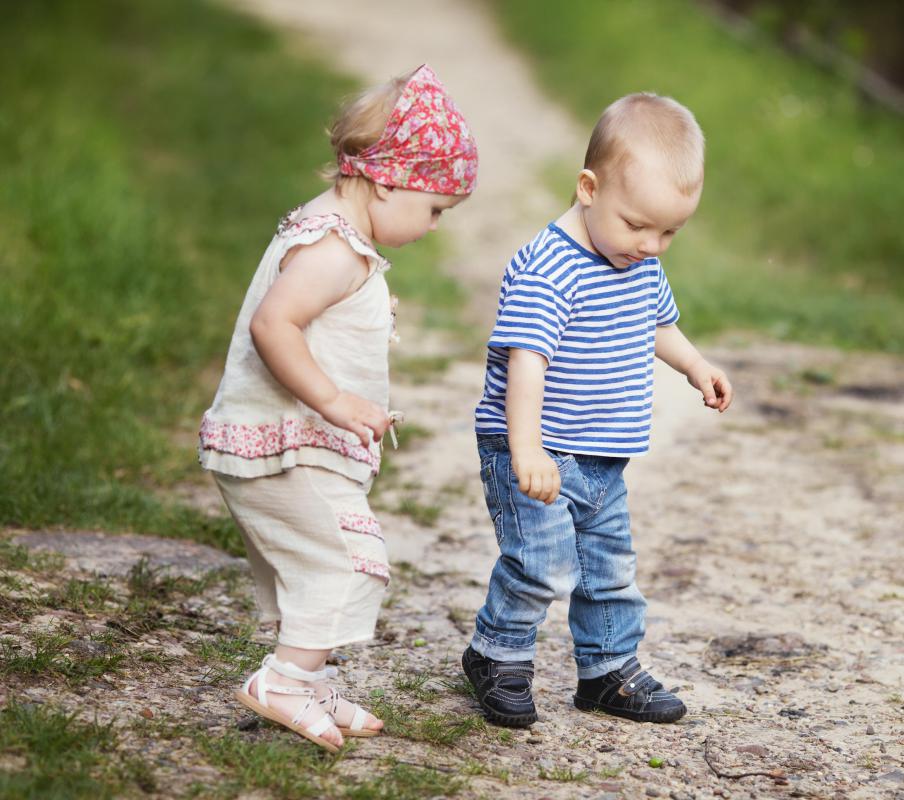At WiseGEEK, we're committed to delivering accurate, trustworthy information. Our expert-authored content is rigorously fact-checked and sourced from credible authorities. Discover how we uphold the highest standards in providing you with reliable knowledge.
What Is a Pigeon Gait?
A pigeon gait, also known as in-toeing, is a condition in which the front of the feet turn inward, leading to a walk which somewhat resembles that of a pigeon. In most cases, this gait affects young children and is caused by abnormal orientation of the thigh, lower leg, or foot. Generally, the gait corrects itself as children grow, and consequently it usually does not require treatment. If a child’s abnormal gait does not improve once he has passed through toddlerhood, however, it may be advisable to consult a physician.
The immediate cause of this gait is an inward turning of the feet. When an individual with inward-turning feet walks, his gait often has a shuffling or waddling quality that, in the eyes of some, resembles the gait of a pigeon. It should be noted that in the medical community, this condition is known as in-toeing, and that some may find the term "pigeon gait" to be hurtful.

Most often, this kind of gait affects very young children, becoming apparent as they begin to walk. The underlying cause of this type of gait is usually the abnormal orientation of the bones in the thigh, lower leg, or foot, which in turn causes the feet to turn inward. Often, these bones rotate inward prior to birth in order to allow a baby to fit within the womb comfortably. It is believed that a genetic predisposition for in-toeing may be passed from parent to child. Less commonly, this type of gait may result from an abnormality of the muscles, the nervous system, or both.

Usually, a pigeon gait gradually corrects itself as a child’s walk develops. Physicians once attempted to speed in-toeing correction using special shoes or braces, but as of the early 21st century, most researchers agree these treatments have no real effect on the condition. Thus, while this type of gait abnormality may seem worrying to new parents or guardians, it actually tends to be a temporary condition that resolves itself without the need for medical intervention.

In rare instances, in-toeing may persist beyond toddlerhood. Children who continue to walk with an abnormal gait beyond age three or four should be evaluated by a physician. It may be possible that an older child with a lingering tendency for in-toeing needs corrective surgery, or that he has an underlying neuromuscular condition that needs attention.
AS FEATURED ON:
AS FEATURED ON:













Discussion Comments
@serenesurface-- I'm not a doctor or expert but I don't think so. Hip dysplasia means dislocation of the hip. It may or may not be present at birth. If it is, it's called congenital dysplasia.
I think pigeon gait may develop as a result of dysplasia. But dysplasia may not cause pigeon gait. It may cause limping or other issues. Dysplasia is basically a much more serious condition and it doesn't go away like pigeon gait.
Are pigeon gait and hip dysplasia the same? I know that hip dysplasia is also a congenital issue like pigeon gait.
My friend has a pigeon gait and she's in her twenties, so it's obviously something that did not resolve by itself. It's not very severe but her feet point inwards and this slows her down. When she tries to walk fast, she does have a different gait, but it's not something very bothersome. I've never brought up this topic with her because I'm sure she knows that she has this. And to be honest, it's not a big deal. When people meet her for the first time, they look for a second at her gait and then move on.
Although this issue resolves itself as children grow, I don't think adults who continue to have it need to worry. Unless of course the inward pointing of the toes cause some other vertebral issues that need to be addressed by a doctor.
Post your comments